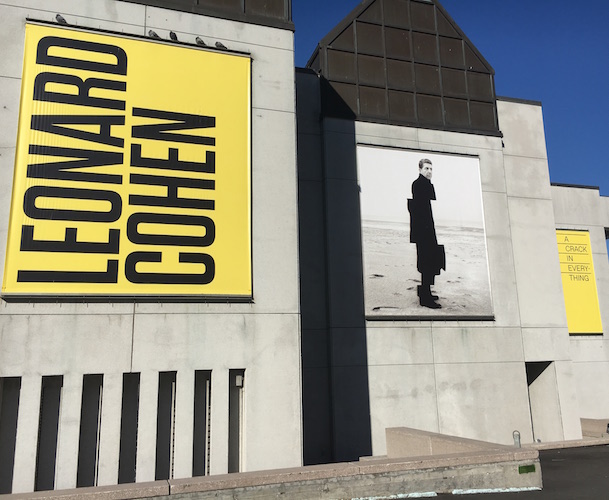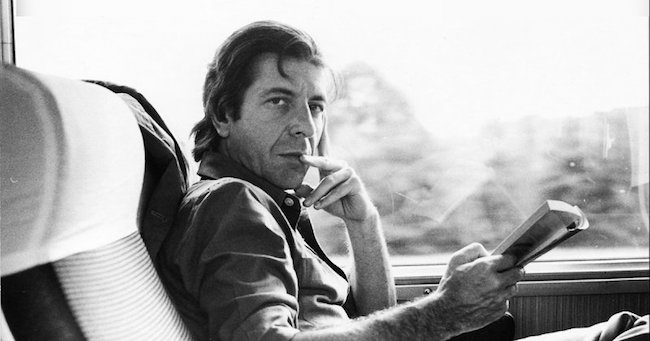Visual Arts Review: Leonard Cohen — Une Breche En Toute Chose/A Crack in Everything
This ingenious and expansive multi-media museum production was well worth the wait, both for fans of Leonard Cohen’s art and for those who new to his artistry.
Leonard Cohen: Une Breche En Toute Chose/A Crack in Everything at the Musée d’art contemporain de Montréal, 185 rue Sainte-Catherine Ouest (corner Jeanne-Mance), Montréal (Québec), through April 9, 2018

The outside of the Musée d’art contemporain de Montréal. Photo: Susan B. Apel.
By Susan B. Apel
Leonard Cohen was still alive when the Musee d’art contemporain in Montreal began to plan the most ambitious exhibition in its history, a celebration of the art of the acclaimed songwriter/poet/novelist/performer. Une Breche En Toute Chose opened on November 9, 2017: it marked the 375th birthday of the city of Montreal and the first anniversary of the death of Leonard Cohen, famous son of Montreal and citizen of the world.
This ingenious and expansive multi-media museum production was well worth the wait, both for fans of Cohen’s music and for those who want an introduction to his artistry. The exhibition succeeds in providing constant discovery, filling six distinct gallery spaces and corners in connecting hallways.
Cohen the performer is captured in “Passing Through,” a multi-channel video projection that fills the walls of a darkened exhibition space with excerpts from his concerts over the past four decades: we watch the performer singing his songs, occasionally musing aloud from the stage. His withdrawal from public appearances during his middle years is evident: the images move from those of a very young Cohen to scenes of his raspy-voiced return to the stage in his late 70s. The space is saturated by Cohen’s voice and image; dazzled visitors creep through the dark to claim the few couches in the center of the room. Most end up sprawled on the floor.
Many admired singers, Judy Collins among them, have performed and recorded Cohen’s songs. Ironically, the museum went in another direction in terms of homage with “I’m Your Man.” It is a 40-minute presentation placed in a gallery in-the-round: 18 unknown and clearly non-professional male singers perform songs from one of Cohen’s later albums. Each vocalist was filmed separately, yet the men are shown performing together in individual screens that circle the room. Their efforts are earnest and imperfect, maybe to illustrate the notion of “the crack in everything.” Perhaps it is meant to be an illustration of how the sophistication of Cohen’s work can be made accessible through the images and voices of multiple versions of Everyman.
There are some intriguing interactive pieces, such as a vintage Wurlitzer organ; when a visitor presses one of its keys he or she will hear an aged Cohen read passages from Book of Longing, his volume of poetry. The study in Cohen’s home, where he used to write, has been reconstructed. At first sight, the layout is the most banal of the exhibition’s offerings — until the viewer eyes the hologram of Cohen outside the room’s window.

Leonard Cohen. Photo: courtesy of the Musee d’art contemporain.
Another gallery presents a different way to interact with Cohen’s work. Labeled “a participatory humming experience,” the installation makes use of one of his most revered songs, “Hallelujah.” One enters a small circular room with other visitors. Microphones hang from the ceiling. You are invited to listen to, and then hum along with, the tune. Your own humming becomes part of the day’s broadcast.
Cohen’s art drew on his depression and, at times, isolation. “Depression Chamber” invites daring visitors to enter, one at a time, “a sarcophagus-like environment.” It turns out to be a sort of artsy isolation tank: Cohen’s tune “Famous Blue Raincoat” plays while iconic, strange visual images accumulate on the walls. It is a solitary experience for the brave.
A number of different artists have contributed to this exhibition, with commissioned works of music, dance, and visual representations, such as a brief video dedicated to Cohen’s song “Bird on a Wire.” These testaments to Cohen add considerable texture, but they can’t withstand competition with the performer’s own voice and image. And Cohen is inescapable outside the walls of the museum as well: celebrations of his life and work extend beyond the museum to other venues throughout the city, with numerous scheduled concerts and light shows.
All in all, A Crack in Everything is an overwhelming experience, with some minor discomforts. The show’s signage is almost non-existent and the lighting is dim, to the point that it might be meant to be an expression of Cohen’s crepuscular vision. This artist saw life as an exercise in stumbling in the dark, a search for illumination.
Susan B. Apel is a writer and law professor whose creative nonfiction and poetry has appeared in Vine Leaves Literary Journal, Best of Vine Leaves 2015, Rhizomes, The Vignette Review, Woven Tale Press, Bloodroot, and the Fredericksburg Literary and Art Review. Her blog, ArtfulEdge, in which she writes about arts in the Upper Connecticut River Valley, appears regularly on the dailyUV.com. She is also a contributor to the newspaper, Vermont Woman. She lives in Lebanon, NH.
